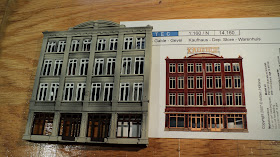Behind the new
passenger terminal, and across from the
"Martel" warehouse, is a long, slim blank area.
Sparse in details, this area is now the focus of my attention. This new project has me now working on 5 separate 'facade' buildings for this area. Three of these are 'Artitec' kits. More photos of these kits un-assembled over on "Scaper's"
Flickr site.
The above building is a kit bash of two Artitec 'facade' structures to raise the height of the building from 3 floors to 5. The building still needs its details, lighting and other elements applied. I may also add a bit more paint. While I like the overall look (the detail came through nicely), it might need a bit more color. To be determined.
The above is clearly a department store of some sort. The package photo clearly shows what apears to be a red brick building, but I'm not so sure I wanted that look, so I tried to stick with a more 'concrete/stucco' style (or painted brick!). I should mention that these Artitec kits need to have extensive cutting of flashing...so every single window needs to be cut, trimmed, etc... They are a lot of work!
The building above is cheating. Its actually an HO kit, but I found that by removing the HO-sized door and replacing it with an appropriate N Scale doorway (I used a leftover double door from the Walthers Hardwood Furniture kit that became the
Martel warehouse) it turned into a fairly convincing N scale building. I don't know what this building is, or what it could be. Some sort of temple, church or something? Whatever it is, its a good urban facade that is unusual and will look really nice I think.
Finally, the above is a structure that is probably pretty familiar to most folks. I believe this is an old Pola mold that was re-marketed and sold by Model Power here in the states. A long time ago, this was a Movie Theater. I'm in the process of converting it to a building with a very Parisian style cafe on the ground floor. The photo to the right of the building gives you an idea of what I am trying for.
When they are complete (lights, details, interiors, paint, etc....) they will look something like the above row of structures. Compare this photo with the photo at the top of this post to kind of get an idea for where I am going. You'll notice the structure to the right (which will be on the corner) is the
kit-bashed/scratch-built Arnold structure.
I do have to say, facades are a lot of fun. I think I enjoy focusing energy on just the 'faces' and not having to put a lot of thought or effort into the 'rest of the building'!
One other thing that I did that was different was my painting technique for the three Artitec buildings (most noticeable on the 'temple' building as well as the 5 story facade). I tried I technique I read (or looked at) in the French model train magazine "
Loco Review" (no, I can't read French, but the photos are pretty good - plus some of the words can be looked up or are easily translatable to English!).
Anyway, the technique is to paint the buildings in all black paint (spray can is fine - similar in a way to how Games Workshop / Warhammer painting is recommended), and then spray over the black with an air brush. Because I'm lazy, I usually prefer spray cans to the air brush (cleaning and all that!) but I have to say the little bit of extra effort to use the air brush (and the nice pallette of paints available) really makes the details pop and the black under-coat really gives a natural texture to the surface that the rather crude coverage of a spray can can't match.
Hopefully in my next post I'll have things lit up and shining on the layout!






















